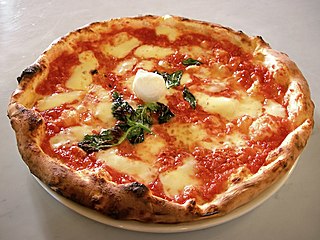
Mozzarella is a traditionally southern Italian cheese made from Italian buffalo's milk by the pasta filata method.

Three European Union schemes of geographical indications and traditional specialties, known as protected designation of origin (PDO), protected geographical indication (PGI), and traditional specialities guaranteed (TSG), promote and protect names of agricultural products and foodstuffs. Products registered under one of the three schemes may be marked with the logo for that scheme to help identify those products. The schemes are based on the legal framework provided by the EU Regulation No 1151/2012 of the European Parliament and of the Council of 21 November 2012 on quality schemes for agricultural products and foodstuffs. This regulation applies within the EU as well as in Northern Ireland. Protection of the registered products is gradually expanded internationally via bilateral agreements between the EU and non-EU countries. It ensures that only products genuinely originating in that region are allowed to be identified as such in commerce. The legislation first came into force in 1992. The purpose of the law is to protect the reputation of the regional foods, promote rural and agricultural activity, help producers obtain a premium price for their authentic products, and eliminate the unfair competition and misleading of consumers by non-genuine products, which may be of inferior quality or of different flavour. Critics argue that many of the names, sought for protection by the EU, have become commonplace in trade and should not be protected.

The following four classifications of wine constitute the Italian system of labelling and legally protecting Italian wine:
In Spain, the denominación de origen is part of a regulatory geographical indication system used primarily for foodstuffs such as cheeses, condiments, honey, and meats, among others. In wines, it parallels the hierarchical systems of France (1935) and Italy (1963), although Rioja (1925) and Jerez (1933) preceded the full system. In foods, it performs a similar role, namely regulation of quality and geographical origin among Spain's finest producers. There are five other designated categories solely for wine and a further three specifically covering food and condiments, all recognised by the European Union (EU). In Catalonia, two further categories – labelled A and Q – cover traditional Catalan artisan food products, but were not recognised by the EU as of 2007. In recent decades, the concept of the denominación de origen has been adopted by other countries, primarily in Latin America. In 2016, the use of the Denominación de Origen (DO) wines were registered as a European Union Protected Designations of Origin/Denominación de Origen Protegida (PDO/DOP), but the traditional Portuguese term of DO can still be used legally on labels.

Bryndza is a sheep milk cheese made across much of East-Central Europe, primarily in or around the Carpathian Mountains of Slovakia, Romania and southern Poland. Bryndza cheese is creamy white in appearance, known for its characteristic strong smell and taste. The cheese is white, tangy, crumbly and slightly moist. It has characteristic odor and flavor with a notable taste of butyric acid. The overall flavor sensation begins slightly mild, then goes strong and finally fades to a salty finish. Recipes differ slightly across countries.

Jamón is a kind of dry-cured ham produced in Spain. It is one of the most globally recognized food items of Spanish cuisine. It is also regularly a component of tapas.

Bergkäse refers to a number of varieties of cheese produced in the Alps. This includes products of mountain farming, the cultivation of alpine pastures as well as the milk processing of local producers in dairies. The term does not say much about the type or production method of the product called mountain cheese, which is usually a hard or semi-hard cheese with no or little holes, usually with a natural rind, but there are also semi-hard cheeses and soft cheeses under this designation. The term is used also generically for Swiss-type or Alpine cheeses, which resemble these in taste and texture but do not come from one of the traditional cheese making regions. The texture is rather hard, sometimes with small holes or cracks, the flavour strong and often a bit nutty.
Bryndza Podhalańska is a Polish variety of the soft cheese Bryndza, from the Podhale region, it is made from sheep's milk.

Neapolitan pizza also known as Naples-style pizza, is a style of pizza made with tomatoes and mozzarella cheese. It must be made with either San Marzano tomatoes or Pomodorino del Piennolo del Vesuvio, which grow on the volcanic plains to the south of Mount Vesuvius, and Mozzarella di Bufala Campana, a protected designation of origin cheese made with the milk from water buffalo raised in the marshlands of Campania and Lazio in a semi-wild state, or Fior di Latte, a cow's milk mozzarella created according to the procedure for which it was registered as a Traditional Speciality Guaranteed (TSG). Pizza Napoletana is a Traditional Speciality Guaranteed (TSG) product in the European Union and the United Kingdom, and the art of its making is included on UNESCO's list of intangible cultural heritage. This style of pizza gave rise to the New York-style pizza that was first made by Italian immigrants to the United States in the early 20th century.

Rupjmaize is a traditional dark bread made from rye and is considered to be the staple of the Latvian diet. The first written references to Latvian rye bread are found in a recipes book dating back to 1901.
Strada dell'olio is a kind of gastronomical route in Italy that crosses a territory rich of traditional products, PDOs and PGIs, DOCs and DOCGs in Italy. It is sometimes linked to an enological tour.
Imokilly Regato is a cows' milk hard cheese made in Mogeely, County Cork, Ireland.

Protected Designation of Origin (PDO) is a type of Geographical Indication of the European Union and the United Kingdom aimed at preserving the designations of origin of food-related products. The designation was created in 1992 and its main purpose is to designate products that have been produced, processed and developed in a specific geographical area, using the recognized know-how of local producers and ingredients from the region concerned.

Haymilk is dairy milk produced from animals that have mainly been fed fresh grass and (dry) hay, rather than fermented fodder. The milk is thus produced according to the tradition in the Alps. The term hay milk is registered as a Traditional Speciality Guaranteed in the UK and the European Union, and can only be used for milk produced corresponding to those specifications.











